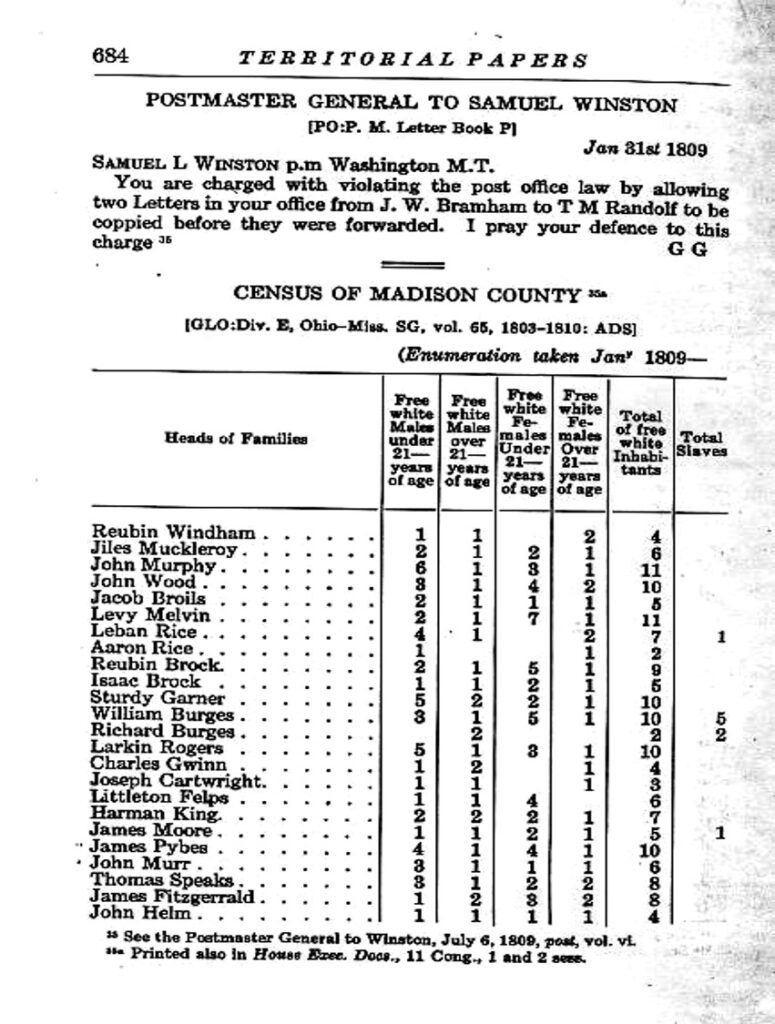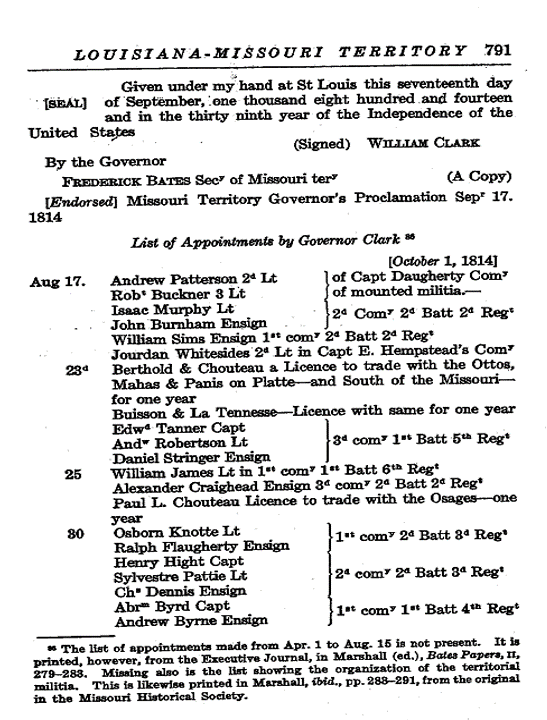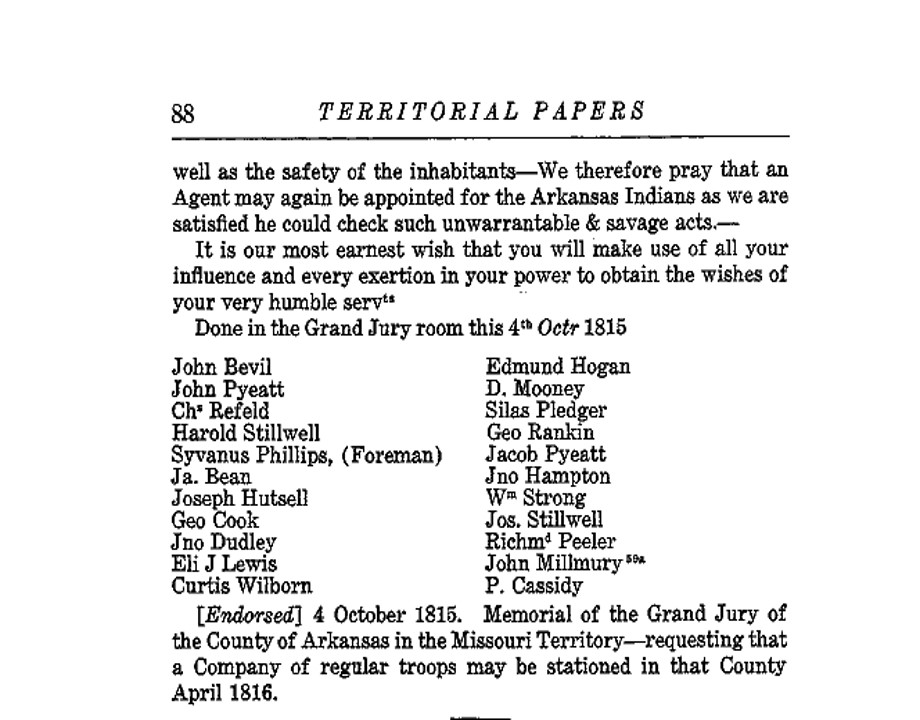Territorial Papers of the United States: A Genealogical Goldmine

The Territorial Papers of the United States are the best-known source of territorial records. The published twenty-eight-volume set of transcribed, indexed, and annotated documents pertaining to the administration of some of the territories of the US covers the Old Northwest, the Southeast, and Midwest:
- 1 General
- 2-3 Territory North of the Ohio, 1787-1803
- 4 Territory South of the Ohio, 1790-1796
- 5-6 Territory of Mississippi, 1798-1817
- 7-8 Indiana Territory, 1800-1816
- 9 Territory of Orleans, 1803-1812
- 10-12 Territory of Michigan, 1805-1837
- 13-15 Territory of Louisiana, 1803-1821
- 16-17 Territory of Illinois, 1809-1818
- 18 Territory of Alabama, 1817-1819
- 19-21 Territory of Arkansas, 1819-1836
- 22-26 Territory of Florida 1821-1845
- 27-28 Territory of Wisconsin, 1836-1848
Before a state became state, it was a territory with an appointed territorial governor along a territorial legislature and other governmental offices. And where there is government, there is paperwork: listings of officials, petitions to the government, correspondence of the territorial governor, letters back and forth among governmental officials, slavery issues, Native American affairs, etc.
Some History
For years, these records were ignored and just housed in various agencies (Department of State, Library of Congress, the then-Department of War, etc.) until the 1911 publication of the Calendar of Papers in Washington Archives of the United States (to 1873) by David W. Parker. The preface to this work laments the difficulty of finding territorial documents in the numerous archives they could be stored in. To remedy this historical oversight, a four-decades long project was undertaken to gather and reproduce the most important documents pertaining to the territories of the US from 1789-1848. The first volume was published during Franklin Roosevelt’s presidency (1934); the last during Gerald Ford’s (1975).
Selected papers of the US Senate relating to territorial affairs were microfilmed and placed on twenty reels as “Territorial Papers of the United States Senate, 1789-1873”, since the department administered territories until 1873. Documents dated earlier or later than the period of the existence of a particular territory are frequently included. It is estimated that the published documents represent just five percent of National Archives documents about each of the territories. Complete sets of the published volumes are free to search on the HathiTrust and FamilySearch web sites.
In 1975 Congress “suspended” (a better term would be “killed”) the project, justifying the action on the high cost of publishing. The last volumes published were those for Wisconsin Territory, which was admitted to statehood in 1848. This left the papers of the great majority of territories west of the Mississippi unedited and unpublished. In 1989, the National Archives launched the series The Trans-Mississippi West, intending it to be a “continuation” of the Territorial Papers project. It consists of guides to records of federal agencies rather than edited versions of the records themselves. More on the continuation later.
So what exactly are territorial records? They are basically anything having to do with governing and administering a US territory. They include a variety of documents such as:
- Original letters from governors and secretaries of territories to President or designated cabinet secretary
- Journals of executive proceedings in territories
- Acts of territorial legislatures
- Letters and documents predating establishment of a territory
Getting Started
As with any research in federal records, when searching for territorial documents pertaining to your ancestors, it’s important to determine how your ancestor would have interacted with federal officials. If you can narrow down the types of contact, you might be able to find your ancestor in these records. Was he involved in a military capacity such as army or militia? Did he perform civil service such as a jury member? Did he sign a petition or make a land claim?
Following is a discussion of a variety of records created at the federal level that may help you learn more about the lives of your frontier ancestors and perhaps help you solve a mystery or two.
These are some of the things you can learn about the persons listed in The Territorial Papers:
- Migration trail of ancestor through multiple territories or states
- Insights into personal feelings, cultural settings, literacy, hardships, and historical details about an individual
- Offices held
- Jury service
- Texts of petitions and names of potential family members who may have signed petitions
- Information about individuals who lived in the area prior to its becoming a part of the US
Some territories also appear in volumes other than their own. Depending on the time period your ancestor was in a territory, it’s a good idea to see if that territory was formed from one or more territories, and if so, which one(s). Here are the pertinent territories and volumes:
- Alabama Mississippi (Vols. 5-6) and South of River Ohio (Vol.4)
- Arkansas Louisiana (Vols. 13-15)
- Illinois Indiana (Vols. 7-8) and North of River Ohio (Vols. 2-3)
- Indiana North of River Ohio (Vols. 2-3)
- Michigan Indiana (Vols. 7-8) and North of River Ohio (Vols. 2-3)
- Minnesota Indiana (Vols. 7-8) and North of River Ohio (Vols. 2-3
- Mississippi South of River Ohio (Vol. 4)
- Wisconsin Illinois (Vols.16-17), Indiana (Vols. 7-8), North of River Ohio (Vols. 2-3)

Mississippi Territory, p. 684.
Territorial Censuses
Both the federal and some territorial governments took censuses of territories. Some territorial governments took theirs between federal censuses in years ending in five. Below are the federal territorial censuses:
- 1807: Randolph and St. Clair Cos as part of Indiana Territory
- 1810: Randolph Co. only exists as part of Indiana Territory
- 1834: Territorial census for Crawford, Brown, and Iowa Cos., located in the western part of Michigan Territory.
- 1836: Territorial census
- 1837: Territorial census
- 1838: Territorial census lost, except for counties of Brown, Calumet, Crawford, Dodge, Fond du Lac, Green, Jefferson, Manitowoc, Marquette, Milwaukee, Portage, Sheboygan, and Washington
- 1842: Territorial census
- 1846: Territorial census, except for counties of Crawford, Chippewa, Fond du Lac, LaPointe, Grand Rapids in Portage, Richland, and Sheboygan
- 1847: Territorial census, except for counties of Chippewa, Rock, Sheboygan, Washington, and Waukesha.
You can go to the FamilySearch Research Wiki, click on “North America”, then click on any state of interest that was originally a federal territory. On the state page on the right, click on “census” to check availability and/or links to state censuses on free and subscription sites such as FamilySearch and Ancestry.com.

American State Papers: Public Lands and the Territorial Papers
A previous blog post showed that in the 1830s Congress had papers of the first fourteen Congresses published as the American State Papers. Eight volumes of the Papers comprise the Public Lands class, and these volumes are most valuable to genealogists working in territorial records. They include military bounty lands, land claims in various territories, grants to settlers, and other useful land records.
When the US acquired lands ceded by foreign governments, landowners had to prove legal ownership. An example of this is in Volume 3 of the Public Lands, “A List of Persons who have had confirmation made to them by the Governors, in virtue of actual cultivation and improvement in the Illinois country, for quantities less than four hundred acres.” You can access the Public Lands volumes either with the physical volumes in the Grapevine Library’s genealogy collection or free online at the Library of Congress web site “A Century of Lawmaking for a New Nation: U.S. Congressional Documents and Debates, 1775-1875.”

quantities less than four hundred acres.” Kaskaskia Land Office,
Illinois Territory.

1814-1818, continued, p. 665.

Finding Aids to Territorial Papers
There are two guides to these documents. One is The Territorial Papers of the United States, 28 v. (Washington, DC: GPO, 1934-1975), compiled by Clarence E. Carter. The other is The Trans-Mississippi West 1804-1912: A Guide to Federal Records for the Territorial Period, 4 parts (Washington, DC: NARA, 1993-2007), compiled by Robert M. Kvasnicka. Trans-Mississippi West was created by the National Archives as a guide to territorial papers not covered by Territorial Papers. It alerts readers to the research potential and gives location information. It covers the Louisiana Purchase (1803) to 1912 when New Mexico and Arizona became states and all records pertaining to contiguous states west of Mississippi River but excludes the Bureau of Indian affairs. Part I covers Department of State records; Part II covers Department of Justice; Part III covers Department of Agriculture; and Part IV covers Department of the Interior. Each volume has a name and subject index. Papers focus upon, but are not limited to, administrative matters. Some include petitions, memorials, lists of voters, appointees to local offices, jurors, and taxpayers. You can also find this set at HathiTrust.
A great resource for finding aids for territorial laws is in the Grapevine Library Genealogy Room: Prestatehood Legal Materials: A Fifty-State Research Guide, Including New York City and the District of Columbia. 2 vols. Binghamton, NY: Haworth Press, 2005, edited by Michael Ciorazzi, JD and Marguerite Most, JD. It’s a one-stop, wide-ranging guide to the history and development of law in the US and the change from territory to statehood for each current state.
Last Word on Territorial Ancestors
Many more territorial records are available that are not digitized, such as the House Territorial Papers, 1810-1872, Senate Territorial Papers, 1789-1873, House Committee on Territories 1825-1946, and Senate Committee on Territories, 1844-1921. The key is to spend time studying finding aids and devoting research time visiting the National Archives in Washington, DC, and College Park. In some cases, territorial documents may be the only proof available to substantiate family lore, so take advantage of these fabulous resources wherever they’re located.





Recent Comments